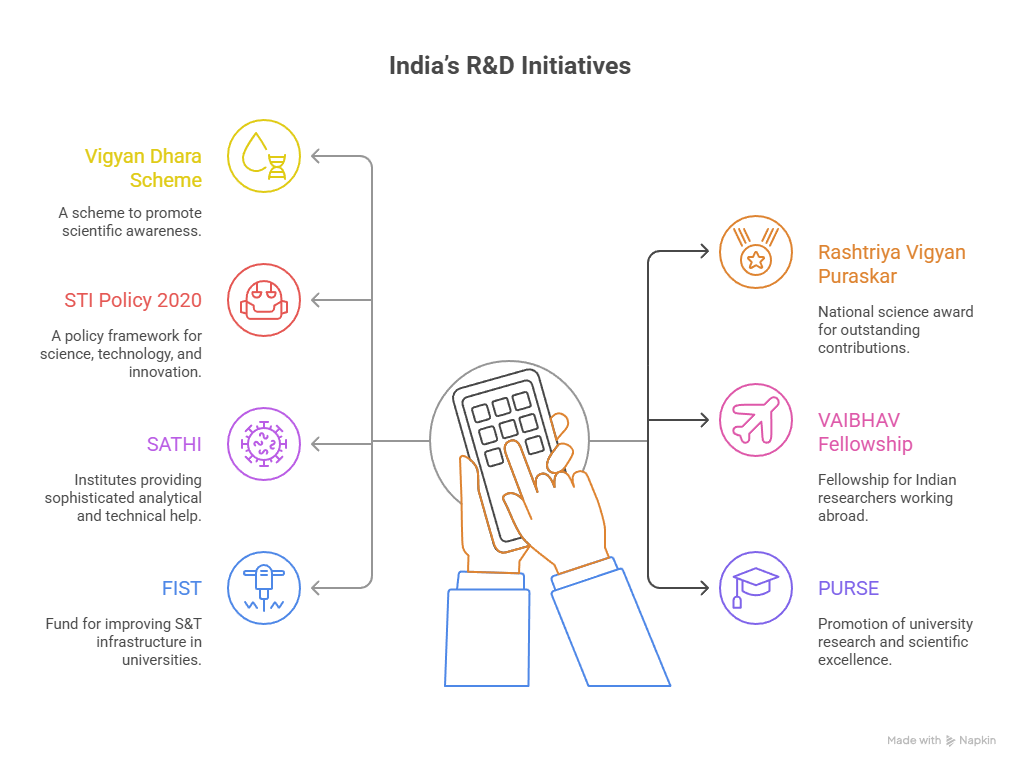Important Facts For Prelims
Research, Development and Innovation (RDI) Scheme
- 05 Nov 2025
- 6 min read
Why in News?
The Prime Minister inaugurated the Emerging Science, Technology and Innovation Conclave (ESTIC) 2025 in New Delhi and launched the Research, Development, and Innovation (RDI) Scheme.
What is the Research, Development and Innovation (RDI) Scheme?
- About: The RDI Scheme is an initiative by the Department of Science & Technology (DST) with a corpus of Rs 1 lakh crore to promote private sector participation in research, innovation, and technology commercialization.
- Objective: To provide long-term financing or refinancing at low or nil interest rates to spur private sector investment in R&D and innovation.
- Key Goals: Support sunrise sectors, strategic industries, and areas critical for economic security and self-reliance.
- Finance transformative projects at higher Technology Readiness Levels (TRLs).
- Support acquisition of critical technologies of national importance.
- Establish a Deep-Tech Fund of Funds to promote high-tech startups.
- Governance Structure:
- Anusandhan National Research Foundation (ANRF): The ANRF Governing Board, chaired by the Prime Minister, will guide the RDI Scheme’s strategic direction, while its Executive Council (EC) will set guidelines, appoint fund managers, and define projects in sunrise sectors.
- Empowered Group of Secretaries (EGoS): Led by the Cabinet Secretary who will oversee approvals, sectoral focus, and performance review.
- Nodal Department: Department of Science & Technology (DST) will implement the scheme.
- Funding Mechanism: The RDI Scheme will follow a two-tier funding model, with a Special Purpose Fund (SPF) under ANRF as the fund custodian, channeling resources to 2nd level fund managers like NBFCs.
- Funding will primarily be through long-term concessional loans at low or zero interest, with equity support for startups and possible contributions to Deep-Tech or other RDI-focused Funds of Funds (FoF).
Emerging Science, Technology and Innovation Conclave (ESTIC) 2025
- About: ESTIC is India’s premier STI (Science, Technology, and Innovation) platform, bringing together ministries, innovators, and global leaders to showcase cutting-edge research and drive a new era of scientific leadership.
- It is driven by the vision of Viksit Bharat 2047, aiming to translate this vision into actionable strategies.
- Nodal Department: It is organized by the DST under the guidance of the Office of the Principal Scientific Adviser (PSA) to the Government of India.
- Vision: To harness knowledge, innovation, and technology for national growth and establish India as a key driver of global scientific progress.
- Objectives:
- Advancements in Emerging Science & Technology (S&T).
- Engaging Future Science & Technology Leaders.
- Foster Collaborations (Deep-Tech Start-ups, Industries, Funding Agencies, and Policymakers) to promote engagement in high-tech innovations and solutions.
- 11 Key Thematic Areas: Advanced Materials & Manufacturing, Artificial Intelligence (AI), Bio-Manufacturing, Blue Economy, Digital Communications, Electronics & Semiconductor Manufacturing, Emerging Agriculture Technologies, Energy, Environment & Climate, Health and Medical Technologies, Quantum Science & Technology, Space Technologies, etc
Frequently Asked Questions (FAQs)
1. What is ESTIC 2025?
ESTIC 2025 is India’s premier Science, Technology & Innovation conclave organised by DST and the PSA’s office to foster collaboration among academia, industry, policymakers and global experts across 11 thematic areas.
2. What is the RDI Scheme and its corpus?
The RDI Scheme, launched by DST, is a Rs 1 lakh crore fund to promote private sector-driven R&D via concessional long-term financing, equity support, and a two-tier funding model managed through ANRF’s Special Purpose Fund.
3. How will the RDI Scheme be governed?
Governance combines the ANRF Governing Board (chaired by the Prime Minister) and an Executive Council for strategic direction, with an Empowered Group of Secretaries (EGoS) for approvals and performance oversight.
UPSC Civil Services Examination, Previous Year Questions (PYQs)
Prelims
Q. With the present state of development, Artificial Intelligence can effectively do which of the following? (2020)
- Bring down electricity consumption in industrial units
- Create meaningful short stories and songs
- Disease diagnosis
- Text-to-Speech Conversion
- Wireless transmission of electrical energy
Select the correct answer using the code given below:
(A) 1, 2, 3 and 5 only
(B) 1, 3 and 4 only
(C) 2, 4 and 5 only
(D) 1, 2, 3, 4 and 5
Ans: (B)
Q. With reference to “Blockchain Technology”, consider the following statements: (2020)
- It is a public ledger that everyone can inspect, but which no single user controls.
- The structure and design of blockchain is such that all the data in it are about cryptocurrency only.
- Applications that depend on basic features of blockchain can be developed without anybody’s permission.
Which of the statements given above is/are correct?
(A) 1 only
(B) 1 and 2 only
(C) 2 only
(D) 1 and 3 only
Ans: (D)







